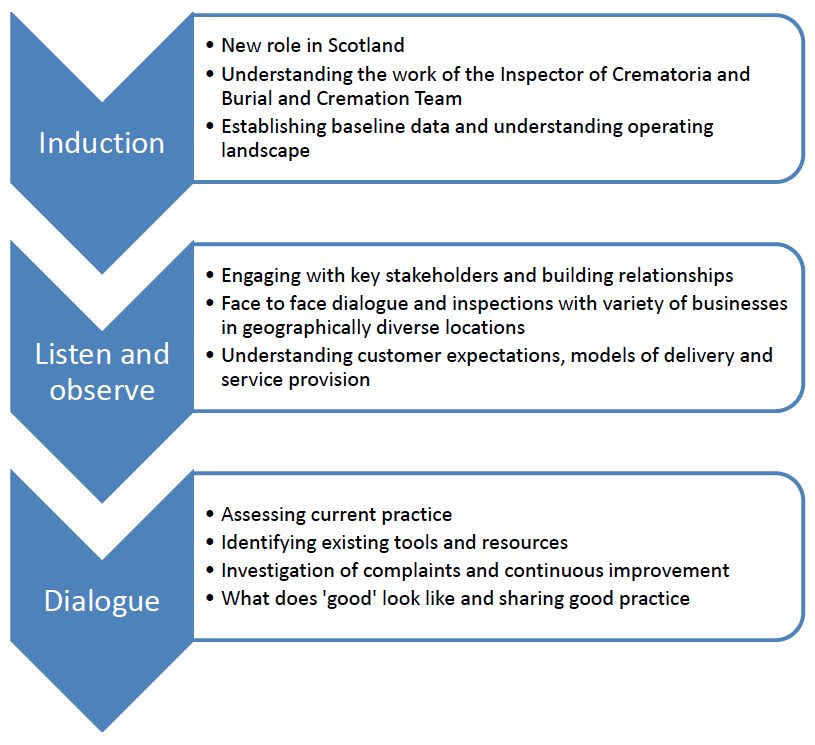Inspector of Funeral Directors: annual report 2017-2018
First annual report from the Inspector of Funeral Directors.
2. Inspector of Funeral Directors work programme update - period July 2017- June 2018
Phased programme of activity over the twelve month period.
The first few months were spent establishing a new network within the sector, meeting with key stakeholders to hear their views on the role and to the current challenges and opportunities that regulation may bring. It was also a time for me to develop my thinking as to how to approach my own work alongside current interventions, such as the existing trade organisation inspections, and to understand how to do this with the limited information the Government had available on a traditionally unregulated sector.
I’d like to thank Scottish Government colleagues, the Inspector of Crematoria Robert Swanson QPM (copy of annual report), trade organisations and a number of stakeholder colleagues for their forbearance as I orientated myself as to the work of the sector, legal processes and how individual good practice is developed and shared.
Infographic:

Infographic plain text:
Induction
- New role in Scotland
- Understanding the work of the Inspector of Crematoria and Burial and Cremation Team
- Establishing baseline data and understanding operating landscape
Listen and observe
- Engaging with key stakeholders and building relationships
- Face to face dialogue and inspections with variety of businesses in geographically diverse locations
- Understanding customer expectations, models of delivery and service provision
Dialogue
- Assessing current practice
- Identifying existing tools and resources
- Investigation of complaints and continuous improvement
- What does 'good' look like and sharing good practice
Introductory inspections by Inspector of Funeral Directors August 2017 – June 2018
As an experienced regulator within a different field of Environmental Health, it was positive for me to see the openness and desire to engage in this new way of working. Despite having no statutory powers at this stage, I have had a positive response from colleagues across Scotland when requesting access for an inspection. As my principal role is to carry out an assessment of the work that happens on the ground, it is best informed by seeing operational practice as it occurs in communities and speaking to funeral directors and their teams, so I thank those involved for that participation and opportunity.
In developing the approach, I listened to feedback from the sector in relation to gaining an understanding of the variations across the country in terms of service delivery, scale and relationships with communities. In addition, it was vital that I take account of the expectations and needs of individual bereaved families and the way in which funerals would be provided both pre and at time of need. I drew from previous experience of regulatory models in developing my interface with the sector, and found this was a positive way to engage with individual businesses. This inspection model is set out in Figure 1.
Figure 1 – sector inspection model to interface with funeral directors

Colleagues in Scottish Government concurrently developed a baseline register of funeral directors through engagement with local authorities, Health Boards and online research allowing me to better understand who was operating in Scotland, and to form the basis of an inspection programme. Current information indicates that there are 696 funeral director branches providing services to the public (as at 1 June 2018). This figure is to be confirmed, and kept under review with further work also on-going to refine data on numbers of business and distinct premises.
In further developing my approach to inspections, it was important for me to consider the feedback I received from colleagues in the early days of my appointment, who felt that I needed to visit a variety of premises from large corporate facilities, multi-site locations to larger and small independents. To do this in geographically diverse locations was important to ensure that I understood the challenges for both urban and rural settings.
As highlighted in these photos, I’ve developed the first stage of the programme to take account of these comments, having carried out inspections from Skye, Shetland, Coatbridge, Rutherglen, Dundee, Edinburgh and Glasgow, and a variety of locations in between. These inspections will, and are, informing thinking on a regulatory approach which is scale-able and fit for purpose for a range of different types of businesses, in a variety of locations across Scotland.
In order to fully understand operational practices and service delivery to the bereaved, and examining in detail areas relating to care of the deceased as a stated priority, my inspection audits are developing focus within five key areas as set out below.
1. Culture, ethos and confidence in management – including an understanding of the business model (direct service provision, contract arrangements, informal support or business partnering arrangements – coffin supplier, conveying, care of deceased including embalming, carriage of families or deceased to funeral), assessment of in-house/contractual capacity against known business demand, investment strategy, governance and leadership arrangements, training and expertise, trade membership, internal audits/self-assessment and awareness, customer feedback, improvement appetite and continuous improvement loop.
2. Conveyance and care of the deceased – staffing model, ‘who does what’ and has what responsibility for care, logistical arrangements for carriage and care, identification process and audit and tracking arrangements, training and experience of staff, practices, premises and capacity for storage and care of the deceased, including first offices, mortuary care. Management of care practices and procedures. Suitability of equipment and vehicles – clean and well maintained.
3. Understanding, recording and acting on the wishes of the deceased or bereaved both pre or at time of need – provision of advice and support and a clear description of choices for funeral arrangements, estimates and invoicing as to services provided, record keeping for wishes and services that have been agreed, and authorisations sought and granted in relation to ashes, memorialisation, and care of the deceased (including embalming). Time to consider and change mind built in, with clearly defined actions flowing from instructions and permissions.
4. Asset management – full premises audit and inspection of all buildings used in the care of the deceased or storage of items relating to the business, including designated and restricted areas for the care of the deceased and storage of ashes, provision and maintenance of suitable and sufficient premises, equipment and vehicles which are clean, well maintained and regularly inspected, suitably trained and experienced staff across the range of duties.
5. Audit of procedures, practice and record keeping – identification and collection of the deceased, recording of funeral arrangements, care of the deceased including record of authorisations and permissions, delivery of funeral according to wishes and contract, opportunities for complaints and feedback informing continuous improvement, ashes retention according to permissions, storage and management, ashes release, completion of records, record storage and management and overall risk management and business continuity planning.
Knowledge and application of Infant Cremation Code of Practice as published, by the National Committee on Infant Cremation, forms part of current inspections, however application of the Code for funeral directors is initially being more widely assessed through the voluntary national survey of funeral directors.
Contact
There is a problem
Thanks for your feedback